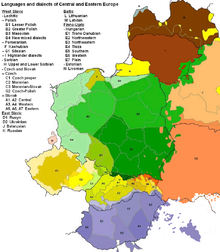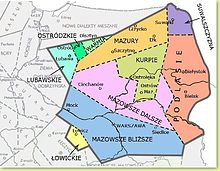- Masovian dialect
-
Masovian dialects dialekty mazowieckie Pronunciation [mazɔˈvʲɛt͡skʲɛ] Spoken in  Poland
Poland
Mazovian Voivodeship
Podlaskie VoivodeshipLanguage family Writing system Latin (Polish alphabet) Language codes ISO 639-3 – Linguasphere 53-AAA-cc
(varieties: 53-AAA-cca to 53-AAA-ccu)- This is a sub-article to Dialects of the Polish language
Mazovian (Masovian) dialects of the Polish language are characteristic of Mazovia and historically related regions, in northeastern Poland.[1] They are the most distinct of Polish dialects and the most expansive.[1]
Mazovian dialects may exhibit such features as mazurzenie, liaison (nieudźwięczniająca) (ubezdźwięcznienie) consonants before vowels in nagłosie next word), and asynchronous palatal pronunciation of labial consonants (softened). The Kurpie region has some of the most distinctive phonetic features due to isolation. Characteristics include:
- ke, ge → kie, gie; kę, gę → ke, ge (e.g. nogie, rękie, kedy, kerować);
- No palatalization of L (e.g. lytr, lysa, lymuzyna);
- the instrumental plural form –mi is pronounced –my;
- developed gumline consonants: sz, ż, cz, di w s, z, c, dz
- harder pronunciation in the frontal position: instead of lipa -> lypa
- -oju ending in masculine singular Dative
- change of y into i: dim, ribi, sin, bik, if its followed by a consonant, the consonant remains hard
- the double-number -wa ending remains in use in plural verbs relating to plural,
- no difference between soft and hard k ang g, including ki i gi, ch in chy is always soft while in che or chę it is not always the case;
- e and o are pronounced as a joint sound of e with i and o with u
- nasal vowels developed as u instead of ą and a instead of ę;
- -eli ending in plural of the past tense
- change of a into e in words: beginning with ra-, ja-, -ar- in the middle of a word -ar- in past verb tenses. Also, in words such as powjedać, wjetrak, zawjesy, śnijedańe;
- accomplished articulating of the following consonants: p, b, w, f, m into pj, bj, wj, fj, mj or pś, bź, wź, fś sometimes simplicised into ńasto "miasto", kańeń "kamień" (ona) ńała "miała" which is changed at times for soft n. In company with lip consonants the following forms are common: śfyńa, śfat, śfeca, ćfartka, ńedźweć, -amy in plural instrumental case and in pronouns like me "mnie" and my "mi"
Masovian dialects also contain certain vocabulary that is distinct from the standard Polish language.
Subdialects
Mazovian dialects include but are not limited to subdialects[2] (gwaras of:
-
- Białystock dialect (Polish: gwara białostocka)
- Suwałki dialect (Polish: gwara suwalska)
- Warmia dialect (Polish: gwara warmińska)
- Kurpie dialect (Polish: gwara kurpiowska)
- Masurian dialect (Polish: gwara mazurska)
- Malbork-Lubawa dialect (Polish: gwara malborsko-lubawska)
- Ostróda dialect (Polish: gwara ostródzka)
- Near Mazovian dialect (Polish: gwara mazowsze bliższe)
- Far Mazovian dialect (Polish: gwara mazowsze dalsze)
- Warsaw dialect (Polish: gwara warszawska)
References
- ^ a b http://www.gwarypolskie.uw.edu.pl/index.php?option=com_content&task=section&id=6
- ^ Halina Karas, Gwary Polskie, Dialects and gwary in Poland
Bibliography
- Barbara Bartnicka (red.): Polszczyzna Mazowsza i Podlasia. Łomża-Warszawa 1993.
- Anna Basara: Studia nad wokalizmem w gwarach Mazowsza. Wrocław-Warszawa-Kraków 1965.
- Anna Cegieła: Polski Słownik terminologii i gwary teatralnej. Wrocław 1992.
- Jadwiga Chludzińska-Świątecka: Ze studiów nad słowotwórstwem gwar mazowieckich. Poradnik Językowy, z. 6, 1961, s. 253-258.
- Karol Dejna: Dialekty polskie. Ossolineum 1993.
- Barbara Falińska (red.): Gwary Mazowsza, Podlasia i Suwalszczyzny.ɴ I. Filipów, pow. Suwałki, Białystok, 2004.
- Województwo płockie. Uniwersytet Łódzki, Łódź-Płock 1984.
Categories:- Polish language
- Poland stubs
- Language stubs
Wikimedia Foundation. 2010.


